On July 16, both members of the pair flew together just before sunrise. this is the female, distinguished by her larger size:
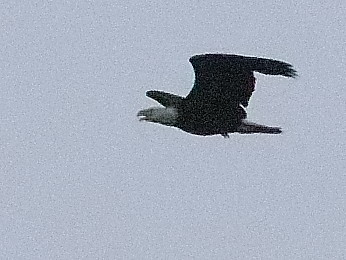
This was the male on July 16:
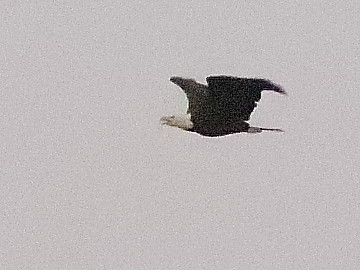
The female flew low overhead on August 13:
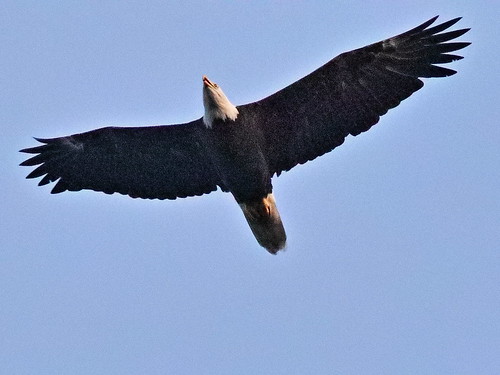
Here is the male on August 26:
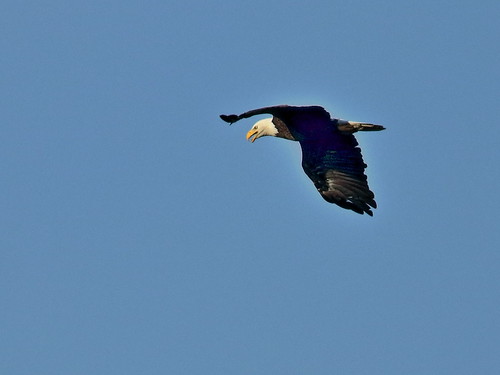
During the summer the eagles have been sighted resting atop of this lighthouse on the island in the biggest lake in our Sunset Lakes subdivision, which is about 2 miles southeast of the nest (click on photo for better view):
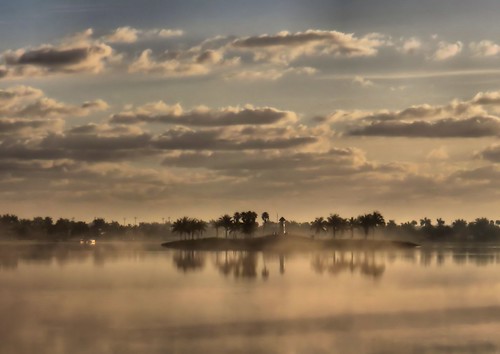
The "official" breeding season begins on October 1, about three months earlier than in the northern reaches of the eagles' range. Both members of the pair were present at the nest on September 14, 2019. The female (Jewel) was roosting on a branch just a few yards east of the nest...
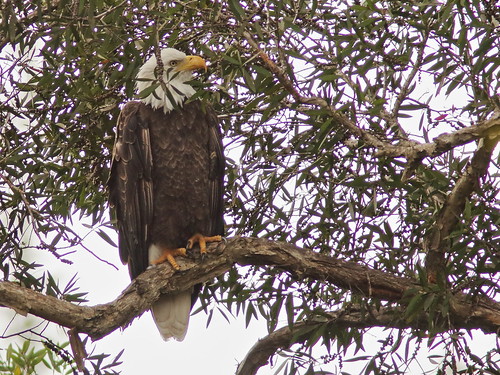
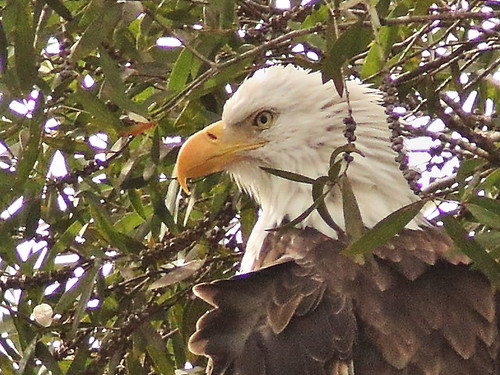
...while the male (Pride) was mostly hidden as he roosted just to the right of the nest. Note that fresh green branches have been added:
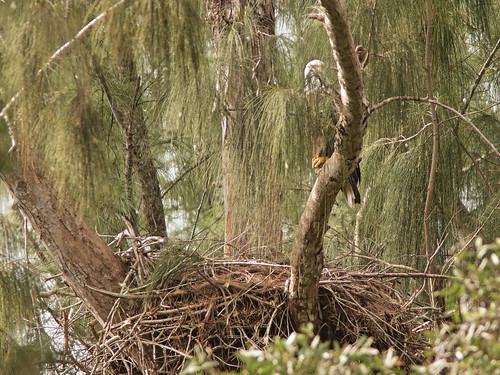
On September 21, the pair were busy at restoring the nest, or "nestoration." The male (to the left) continuously brought in sticks, while the female kept watch and adjusted their placement:


Off goes the male to find more sticks. In flight, he often breaks them off from dead trees:

Following is a review of their prior (2018-2019) breeding season. Pride is the original male who was first seen at this nest site in 2007. Since breeding age is 5 years, he is now at least 17 years old. Jewel is his second mate. His first mate (Joy), disappeared in late October, 2014 after hatching 13 eaglets in 7 broods, of which 11 successfully fledged. She was quickly replaced by a 4 year old female (Jewel) who did not breed in 2014-2015.
Then, in 2015-2016 Jewel lost her first nest and its only eaglet in a storm. Bald Eagles occasionally nest a second time if they lose eggs or a brood early in the season. That year, because of widespread storms, this occurred with several pairs around Florida. Jewel indeed nested a second time. To date, her 5 attempts have produced 9 known young, 6 of which survived to fly free.
Here is the pair last season, roosting in a tree near the nest on October 7, 2018. The male (Pride) is to the left, while his mate (Jewel) is perched higher up. Note that the male's smaller body is more tapered towards the tail end while Jewel is much more filled out "below the waist:"
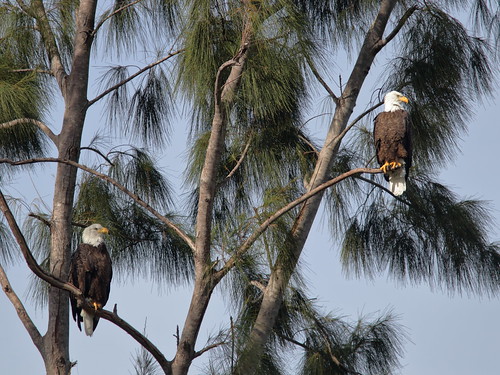
The pair spent much time preening:
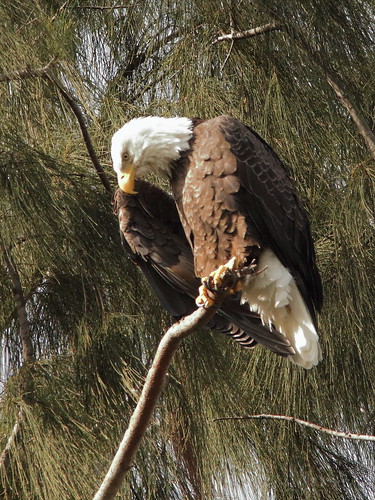
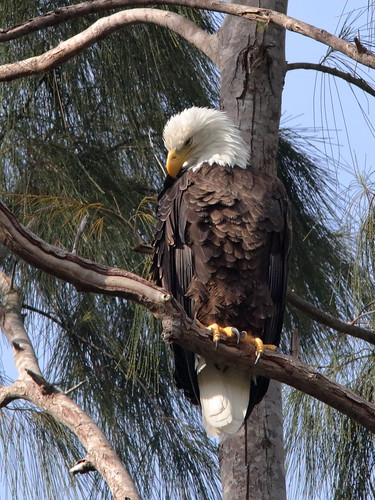
When Pride finished preening he got all ruffled up:
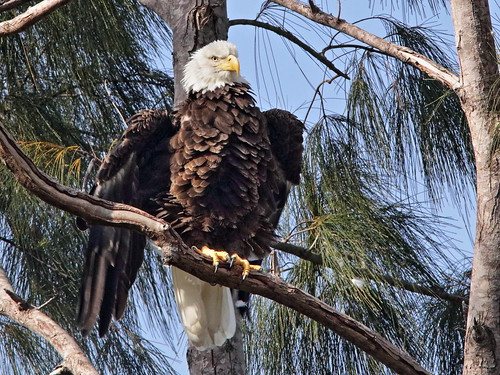
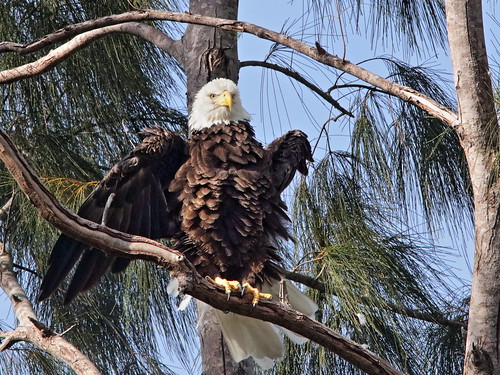
A closeup of Jewel's talons shows the elongated hind toe (hallux), characteristic of the female:

Jewel is checking out something on the ground below:
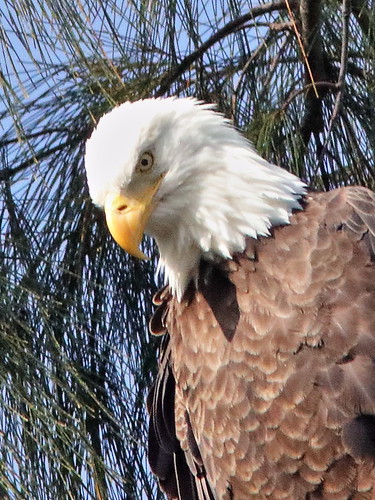
The nest appeared to have some new sticks added:
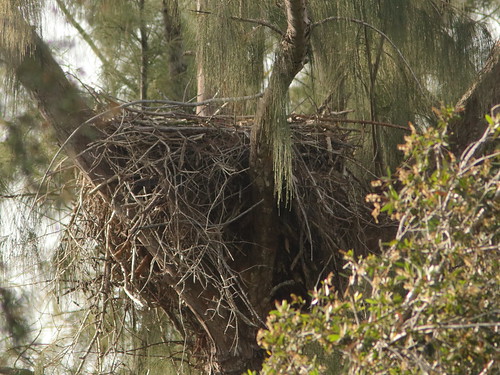
The pair worked on the nest into mid-November, and courtship activity increased. On November 17, 2018 they copulated successfully.
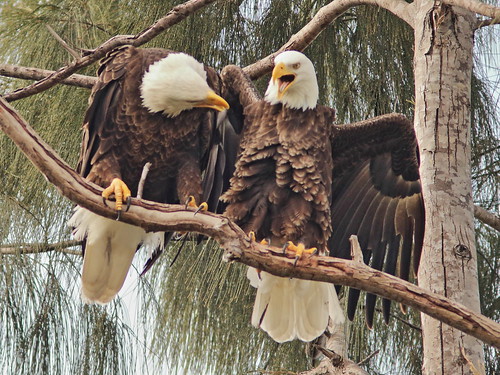


Their first egg was laid about December 5, and it hatched around January 10, 2019.* Two eaglets were first seen on January 31, 2019:


The first egg to hatch is more often a female, with a chance of about 2 out of 3. Here are the two eaglets, from left to right, the male (P Piney 22) and female (P Piney 21) at about 11 weeks of age, on March 16, 2019:

Both fledged on successive days just one week later. They immediately returned to the nest to be fed:
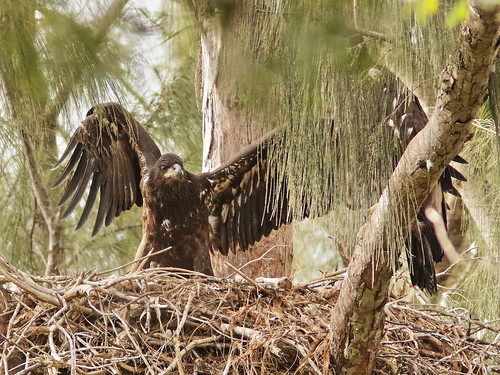
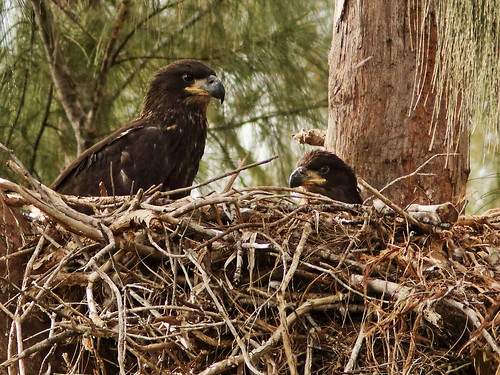
There was a chaotic food drop on April 14, when the male parent flew in with unidentified prey, but both eaglets attacked fiercely, driving the adult back:

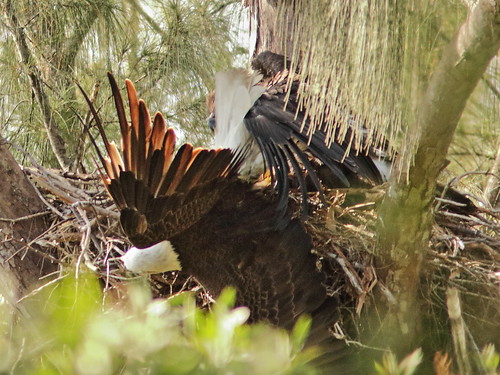

The older eaglet then crouched down over the prey and spread her wings to guard it while the younger eaglet settled down behind her:

By mid-May, both youngsters had migrated away, probably to find cooler water to the north, where fish tend to be nearer the surface and are easier to catch.
As of this writing, in September, 2019, the occupants of this nest of eagles is known to have hatched out at least 22 chicks, of which 17 were confirmed to have fledged successfully. Although we hope all 17 are still alive, the sad fact is that as few as 50% of the Bald Eagles which leave the nest survive into adulthood.
Research shows great variation in survival rates. The proliferation of Florida's eagle population suggests that conditions may be more favorable here. However, when the eagles move into urban areas they are subject to new hazards, particularly motor vehicle collisions and injury from power lines. Aggression between eagles over territories and mates also may become more common where they compete for limited resources. Most mortality occurs within the first few months before the eaglets gain survival skills.
A spreadsheet (PDF) which details observations of this nest since 2008 may be accessed AT THIS LINK.
*In estimating the timing of the laying of eggs and hatching of the eaglets, we must depend upon clues from changes in the behavior of the adults. The onset of incubation coincides with the laying of the first egg, which is when we suddenly see one of the pair down deep and immobile in the nest. Hatching is a time of excitement, as the parents shift position frequently, peer down into the nest, and they start bringing in prey and tearing off bits to feed the tiny chick. The adults also sit a bit higher in the nest after the first egg hatches, supporting themselves on their wings to form a "tent" to shelter the chick and yet provide warmth to any eggs that have not yet hatched.
Volunteer nest observers share their sightings and photos, and respond to queries in the Pembroke Pines Eagle Nest Watch FORUM here, which includes a link to spreadsheets that document observations over the past three breeding seasons .
= = = = = = = = = = = = = = =
Linking to Misty's CAMERA CRITTERS,
Linking to Eileen's SATURDAY'S CRITTERS,
Linking to SKYWATCH FRIDAY by Yogi, Sylvia and Sandy
Linking to WEEKEND REFLECTIONS by James
Linking to BirdD'Pot by Anni
Linking to Our World Tuesday by Lady Fi
Linking to Wild Bird Wednesday by Stewart
Linking to Wordless Wednesday (on Tuesday) by NC Sue
Linking to ALL SEASONS by Jesh
________________________________________________
Please visit the links to all these memes to see some excellent photos on display
________________________________________________
Lucky you, fab photos. Cheers Diane
ReplyDelete22 chicks ... that's pretty cool
ReplyDeleteEagles are so magnificent. Love the story and images of the season of eagles.
ReplyDeleteWow, those talons looks really formidable! Great captures.
ReplyDeleteGreat shots and that sky shot is incredibly. I like it (looks like professional work ).
ReplyDeleteBeautiful shots.
ReplyDeleteWhat a neat, well photographed series on these eagles. They are such fine looking birds. Like your reflections also.
ReplyDeleteHello, Wonderful post on the breeding Eagle couple. I did not realize they start so early nesting in Florida. I hope they continue to do well. Your lighthouse and sky photo is pretty. Awesome photos. Thanks for sharing your post. Enjoy your day, wishing you a great weekend. PS, thanks for the visit and comment.
ReplyDeleteI like the eagle photos and the foggy reflection is amazing!
ReplyDeleteHow exciting! And what a wonderful time of year for living in Florida! I love all of your photos and the great information you've shared. I saw an Eagle this week but I was driving (on my way to the post office) and couldn't get a photo of it. I hope I see another one this week when I'm out with my camera. Enjoy your weekend!
ReplyDeleteWow, Ken, you've left me near speechless with your stellar images!!!
ReplyDeleteThanks for leaving your link & commenting at I'd Rather B Birdin'.
Wonderful photos of the Bald Eagles!
ReplyDeleteHave a blessed day!
Kenneth, while I am over the top about your beautiful and wonderful photos and history of your Eagles (because I volunteer here in CT in monitoring Bald Eagles during our active season (Feb-Jul), I do have one question for you. The photo of the lighthouse...would you tell me the setting that you used to take it? You see, I am a novice at photography and think it is absolutely AMAZING!!!!...:)jp
ReplyDelete@QuietCorner: Thanks-- it was just a candid shot with my accessory pocket camera. I am very pleased with its image stability and use it for nearly all my landscape photos without tripod.
DeleteTaken on February 16, 2015, about 15 minutes after sunrise, looking east on a foggy morning from across the lake, so the original had very little color
Canon EOS 80D handheld; EF 300mm f/4L+1.4x (420mm f/5.6); 1/636 sec; ISO 100 ; EC +/- 0; no flash
Layered three exposures of the same JPG image (original and one stop (+1 and -1)
Processed in "out of the box" Canon Digital Photo Professional.
I increased saturation slightly, which produced an amber tint but no color filters were added
How much work these eagles need to do for their kids to be born and stay alive! I thought because they are big birds it would be easier, but from the details you give, it seems harder, since only 50% survive. Thank you for educating us at All Seasons about the bald eagle. A fierce bird, that has become a symbol for this country! Thank you and have a beautiful week!
ReplyDeleteAbout your comment on still remembering the one place you lived in Florida before: isn't it interesting that some little detail of the crunch of the pine needles underneath our boot is engraved in our memory forever:) And how we can live in other places not being able to remember anything sharply or distinctly!
ReplyDeleteBrilliant photos especially the close ups. It must be really exciting to be able to follow the development of the chicks.
ReplyDeleteOh my :o
ReplyDeleteSuch beautiful photos!
I wish I one day will see that bird i real life.
Here in Swedn the biggest bird is white-tailed eagle.
///Laila
https://tillklippt.blogspot.com/
I really enjoyed seeing the entire process in your photos of eagles lives--from building the nest to the fledgling of the eaglets. It was fascinating. They appear to be good parents. I loved the lighthouse photo!
ReplyDeleteMagnificent birds, and magnificent photos. Thanks for sharing at https://image-in-ing.blogspot.com/2019/09/basilica-shrine-of-saint-mary.html
ReplyDelete